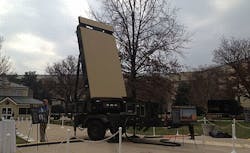Latest order for Marine Corps G/ATOR radar systems brings total number of radars to six
QUANTICO MARINE BASE, Va., 17 March 2015. U.S. Marine Corps are ordering two more early versions of a long-delayed and expensive radar system designed to protect Marines on attack beaches from rockets, artillery, mortars, cruise missiles, unmanned aerial vehicles (UAVs), and other low observables.
Officials of the Marine Corps Systems Command at Quantico Marine Base, Va., announced a $113.3 million contract modification Friday to the Northrop Grumman Corp. Electronic Systems segment in Linthicum Heights, Md., for two low-rate initial production (LRIP) versions of the Ground/Air Task-Oriented Radar (G/ATOR).
The Marines ordered four LRIP G/ATOR radars from Northrop Grumman last December, and Friday's order brings the total number of LRIP G/ATORs to six. LRIP represents small-quantity production for real-world testing before authorities make the decision to enter full-rate production.
G/ATOR is an expeditionary, three-dimensional, short-to-medium-range multi-role radar system designed to detect low-observable targets with low radar cross sections such as rockets, artillery, mortars, cruise missiles, and UAVs.
Marine Corps leaders are developing and fielding G/ATOR in three blocks for use by the Marine Air Ground Task Force across the range of military operations, officials say.
Related: Nine years later, Marines have production of G/ATOR radar in sight
G/ATOR development began more than nine years ago with a $7.9 million contract to Northrop Grumman. The three-increment G/ATOR development involved short-range air surveillance, counter-battery fire and target acquisition, and sensor networking.
story continues below
Northrop Grumman built G/ATOR for short-range air defense (SHORAD) and tactical air operations Center (TAOC) air surveillance missions, including identification friend-or-foe (IFF). The increment I design was to provide for growth to all following increments without equipment re-design and provide an open architecture to enable upgrades with following increments.
The second increment was to develop and produce systems based on the increment I baseline for ground counter-battery and target acquisition. The third increment was to incorporate Mode 5/S IFF, electronic protection equipment and software, non-cooperative target recognition, sensor netting, an advanced radar environmental simulator, and a logistics integrated data environment (IDE).
The G/ATOR program was to showcase new component technologies, including the then-new VPX embedded computing fast switch-fabric interconnect. As part of the G/ATOR program's first increment, Northrop Grumman awarded a $4.3 million contract in 2008 to Curtiss-Wright Corp. for VPX-based embedded computers for radar signal processing, to be delivered by 2010.
A fourth increment to G/ATOR was to incorporate an air traffic control (ATC) capability. That first contract in September 2005 was to conclude in September 2009, and that's when problems cropped up.
By October 2009, the Pentagon reported a $14 million cost overrun to G/ATOR, which was blamed on additional capability added during the previous four years, and to unexpected developments like the rising cost of gold, which made advanced electronic connectors for the military radar more expensive.
By mid-2012, nearly seven years after the program began, the Marine Corps awarded a contract to Northrop Grumman to begin the second increment of developing the Ground Weapons Locating Radar (GWLR) portion of G/ATOR. This 2012 GWLR work involved software installed on the first increment's hardware and operating system software, which Northrop Grumman engineers designed.
The GWLR portion uses active electronically scanned array (AESA) radar technology to enable the system to provide several different radar missions and adapt automatically to changing battlefield conditions. The GWLR is intended to increase detection range, accuracy, and deployability over other counter-battery radar systems.
On the G/ATOR order announced Friday, Northrop Grumman will do the work in Linthicum Heights, Md.; East Syracuse, N.Y.; Stafford Springs and Wallingford Center, Conn.; San Diego and Camarillo, Calif.; Big Lake, Minn.; Londonderry, N.H.; High Point, N.C.; and Woodbridge, Ill., and should be finished by October 2017.
For more information contact Northrop Grumman Electronic Systems online at www.northropgrumman.com, or Marine Corps Systems Command at www.marcorsyscom.marines.mil.

